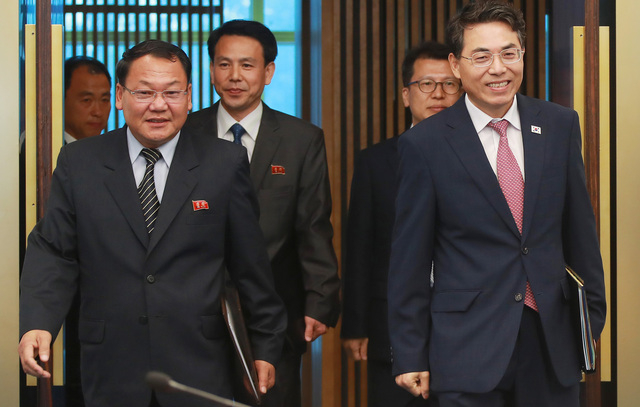 |
|
South Korea’s Second Vice Minister of Land, Infrastructure and Transport Kim Jeong-ryeol (right), and North Korean Vice Railroad Minister Kim Yun-hyok head their respective delegations in the inter-Korean Railroad Cooperation Subcommittee meeting at the House of Peace on the South Korean side of Panmunjeom on June 26. (photo pool)
|
First project targets tracks from Kaesong to Sinuiju tack on Seoul-Sinuiju Line and from Mt. Kumgang to Tumen River on East Sea Line
South and North Korea have agreed to set up a joint research team designed to modernize and connect South and North Korea’s railroad networks. The team is supposed to initiate a joint on-site survey of the North Korean sections of the Seoul–Sinuiju Line and the East Sea Line on July 24. The survey of the section of track from Kaesong to Sinuiju on the Seoul–Sinuiju Line and from Mt. Kumgang to the Tumen River on the East Sea Line is a “preliminary project to modernize the railroad on the Sinuiju and East Sea lines” that the two sides agreed to “move forward with very soon.” The North Korean section of the Seoul–Sinuiju Line was surveyed in Dec. 2007, but this will be the first survey of the North Korean section of the East Sea Line. “The connected sections of track on the Seoul–Sinuiju Line [from Munsan to Kaesong] and on the East Sea Line [from Jejin to Mt. Kumgang] will be jointly inspected in mid-July. Based on inspectors’ findings, necessary follow-up measures will be taken, including construction around the stations and installation of signals and communication equipment,” South and North Korea said. South and North Korea negotiators on the Railroad Cooperation Subcommittee met at the House of Peace on the South Korean side of Panmunjeom on June 26 and adopted a joint press statement. “We confirmed our position that the railroad cooperation that is taking place on the Seoul–Sinuiju and East Sea lines in accordance with the historic Panmunjeom Declaration holds great significance for achieving the balanced development and the joint prosperity of the national economy, and we agreed to work on these projects simultaneously in the future,” the statement said. The two sides “agreed to work on a high degree of connection and modernization of the Seoul–Sinuiju and East Sea lines, to set up specific measures in technical areas including design and construction to achieve those ends and to hold a groundbreaking ceremony as soon as progress is achieved in those areas.” North Korean negotiators reportedly advocated prioritizing repairs on railway facilities that have been neglected during the ten years that rail service was suspended. But during a “two plus two” meeting in which delegates skipped lunch, the two sides acknowledged that international sanctions by the UN and others would require the timeframe to be adjusted. In the end, an agreement was reached to begin with a joint survey of the North Korean sections of the Seoul–Sinuiju and East Sea lines. During a press conference at Panmunjeom held after adopting the joint press statement, Kim Jeong-ryeol, South Korea’s Second Vice Minister of Land, Infrastructure and Transport and its chief delegate in the talks, said “we do not think the sanctions [by the UN and others] will be really violated” even if South Korean staff and equipment is used during the on-site survey of the North Korean sections of track on the Seoul–Sinuiju and East Sea lines. “We agreed to move forward under the principle of simultaneously connecting and modernizing railroads on the East and West Seas to a high level, but we were unable to resolve our differences on confirming the timeframe or practically carrying that out,” said North Korean Vice Railroad Minister Kim Yun-hyok during the closing session, emphasizing that no agreement was reached on the specific timeline of repairing facilities. First inter-Korean railroad discussion in 10 years Regular service of inter-Korean cargo trains along the section from Munsan to Bongdong on the Seoul–Sinuiju Line began on Dec. 11, 2007, following the Oct. 4 Inter-Korean Summit. This restored the crucial artery that had been cut off 56 years ago, in 1951, during the Korean War. But inter-Korean relations rapidly worsened during the first year of Lee Myung-bak’s presidency in 2008, leading to the cessation of inter-Korean rail service in Nov. 28 of that year. The two sides have been unable to resume rail service during the ten years since then. The subcommittee’s meeting was inspired by the agreement reached between South Korean President Moon Jae-in and North Korean leader Kim Jong-un in the Apr. 27 Panmunjeom Declaration to “actively implement the projects previously agreed in the 2007 October 4 Declaration [. . .] and as a first step [. . .] to adopt practical steps towards the connection and modernization of the railways and roads on the eastern transportation corridor as well as between Seoul and Sinuiju for their utilization.” This was followed up by an agreement during high-level inter-Korean talks on June 1 to convene the Railroad Cooperation Subcommittee by the end of June. This was the first inter-Korean meeting about railroad cooperation since the first meeting of the inter-Korean Railroad Cooperation Subcommittee held at the Inter-Korean Economic Cooperation and Deliberation Office in the Kaesong Industrial Complex on Jan. 29 and 30, 2008. During that meeting, negotiators discussed the question of repairing the Seoul–Sinuiju and East Sea lines for their joint use. By Lee Je-hun, senior staff writer Please direct comments or questions to [english@hani.co.kr]






